How to Make Shoes Non Slip for Work – 9 Outstanding Tips to Add Grip to Soles
Do you have a job where you’re constantly on your feet? Does it seem like no matter what shoes or socks you wear, your soles keep slipping and sliding all over the place? If this is a problem that’s been plaguing you for months, maybe even years, then this blog post will be able to help. In today’s article, we’ll be discussing how to make shoes non slip for work.
To make shoes non-slip for work, using grip pads or scuffing the soles with sand paper seem to be the most effective solutions. However, we’ve also experimented other methods to make shoes non slip for work. So, read this guide till the end.
Table of Contents
How Can Non Slip Shoes be Dangerous for You?
Slips and falls are the common causes of injuries in workplaces such as restaurants, hospitals, factories, and veterinary clinics. Some serious injuries have taken place in different workplaces in the past years that have mandated the workers to wear slip-resistant shoes.
Statistics by the Centers for Disease and Prevention show that out of one million Americans suffering from slips and trips incidents, 17000 die from these injuries. According to a study in Great Britain, around one million days are taken off due to the injuries that are caused by slips and falls. These stats urge us to think that why making shoes non-slip has been necessary for workplaces.
Around 20 to 30 percent of people, who experience slip accidents, suffer severe injuries like spinal cord can break or your head can damage. In North America, over 20,000 fatalities occur per year due to slip-falls.
Seeking a lesson from such painful incidents, it has become mandatory to fix slippery shoes so that you can efficiently work in your respective workplaces without any fear of slipping.
How to Make Shoes Non Slip for Work
Let’s dive in and discover a pool of the most effective strategies and techniques that you can apply to add grip to your shoes and make them non slip.
1. Scuffing the Outsole of your Shoes by Scrubbing on Hard Surface to make them Slip Resistant
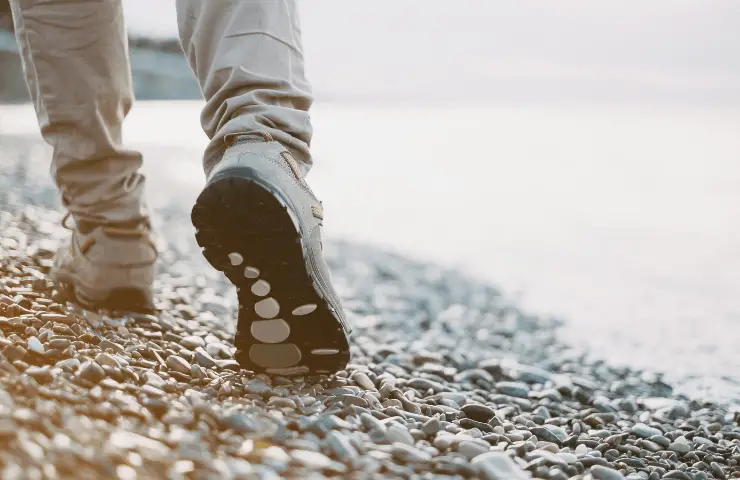
When you buy the shoes, the features you first observe are style, comfort, cushioning, fit, and platform height. The most important feature regarding safety perspective i.e. remains hidden under the blanket of those prominent features.
The sole of most shoes is made of rubber which is smooth and slippery due to the polished finish on them when they are new.
The simplest way you can follow to make the sole slip-proof without using any gadget or tool is to wear the shoes and walk on hard and rough surfaces such as concrete floors or stroll around on uneven rocky surfaces with bumpy rides and full of pebbles. Such hard, rough, and uneven surfaces peel off the smooth finish to the tangle of interwoven fibers of the outsole. In this way, they put micro dents on the sole surface and add grip to the bottom of the shoes.
2. Scrape the Soles with Sandpaper to make them Non-Slip
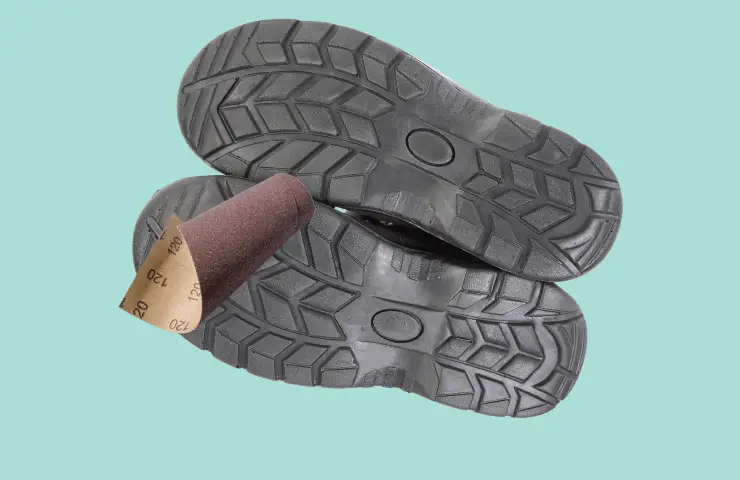
If you don’t walk around for extended miles to scuff your sole and worry about slipping, another way to make it anti-slip for shoes is to take medium-grit sandpaper and scratch it on the bottom of the shoes until the sole gives a rough textured feel. During our testing, we determined that 50-grit sandpaper works effectively in making the soles rough and non-slip.
You can apply the following simple steps to rub the sandpaper against the soles to make them slip-resistant.
Take a medium grit sandpaper. It should be new and should not be rubbed with any surface earlier.
- Grip your shoes firmly and scrap the sandpaper against the bottom of the shoes.
- Apply more pressure on the spots of the sole of the shoes that are in contact with the surface.
- Keep rubbing until you feel a coarse texture on the sole by touching it.
Note: You cannot apply the sandpaper method to all types of soles, especially those with a natural cardboard-like texture that is usually featured in flats and sandals. The heel and ball of the foot region of the shoes are smooth areas that make most contact with the ground.
In this way, by scraping sandpaper with the bottom of the shoes, you can make your shoes’ sole slip-resistant and add grip to the bottom.
3. Use a Nail File to make Shoes Non-Slip
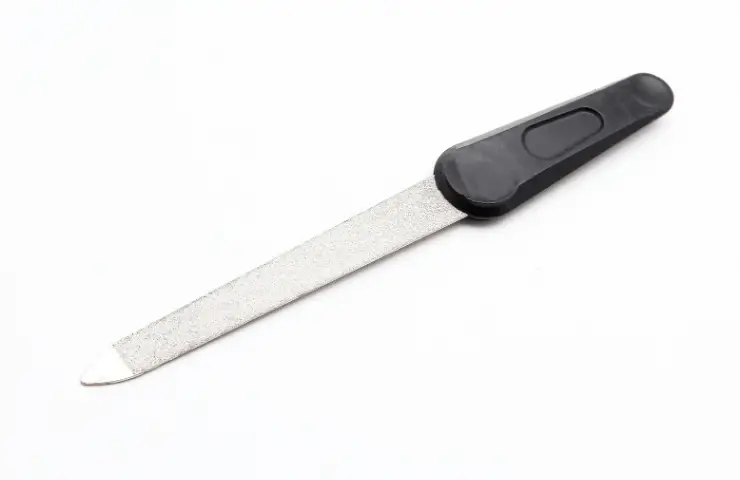
A metal nail file is a simple tool that you can use to make shoes non slip for work. You don’t have to go out to specially buy this tool as it is commonly found in your homes. This method is similar to the sandpaper scraping method as I have discussed above.
A metal nail file can be more effective as compared to the sandpaper as it is sturdy, offers more control due to its grip, and has a well-defined pattern.
Here is how you can apply this method to fix slippery shoes and make them slip-resistant.
- Hold the shoes tightly.
- Swipe your hand across the bottom of the shoes to feel which areas are smooth and softer.
- Now, rub the metal nail file over those areas until the smoother surface of the sole gets rough.
Note: Try to use a coarser nail file as it will help to make your shoes slip-resistant with lesser effort and better effect.
4. Scoring the Soles to Fix Slippery Shoes
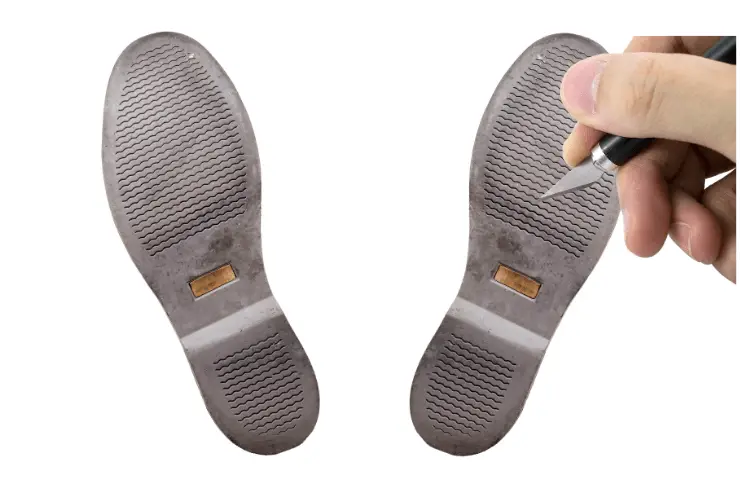
This is another simple, easy and effective trick to make your shoes non slip for work. You will be doubtful while applying this technique as it involves using a knife, razor or any sharp object on your favorite shoes. But believe me, after applying this technique, you will not regret it.
Here is how you can apply the scoring technique to make work shoes slip resistant without destroying their sole quality.
- Place your shoes upside down on the table and hold them tightly.
- Using a razor blade or a penknife with a sharp knock, gently cut shallow and narrow lines on the sole of your shoes.
- In this way, making a lattice-like pattern on the bottom of the shoes will make them look better and slip-resistant.
Note: This method has proved to be effective on the rubber soles for adding grip.
5. Using a Grip pad to add Traction and Make Shoes Slip Resistant
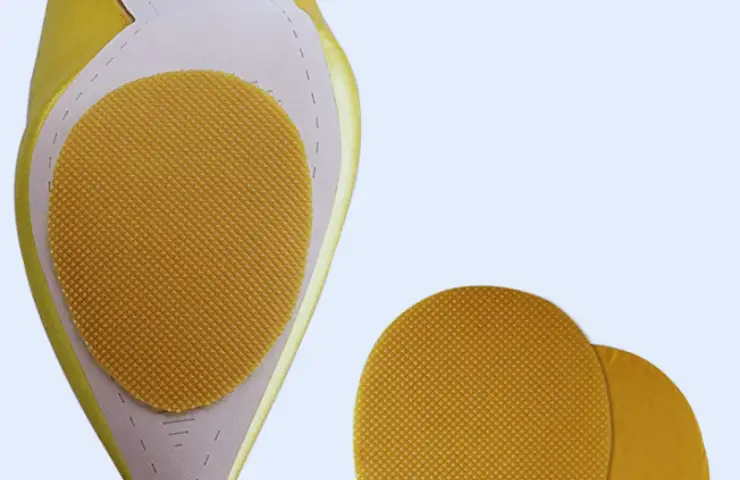
You can apply this method to your old pair of shoes for making them non slip. You can use this method when you are wearing the same shoes for an extended period, and the bottom of the shoes gets deteriorated. It is just like the tyre of a vehicle that has clear visible treads when it is new.
You can see this type of scenario in shoes with the rubber outsoles that lose their treads pattern after being contacted with the ground for a longer period.
You might be thinking to dispose-off your worn out your favorite shoes. Don’t worry; I have found a cheap and cost-effective solution that can add grip for the bottom of shoes and make them slip-resistant again by spending only a few bucks.
There are high-quality textured and adhesive grip pads that are designed to enhance the traction of the heel area of the shoe bottom. The one side of grip pads is adhesive for sticking them on the shoe bottom, and another side is made of durable, rough material.
Some grip pads are designed to fit on any pair of shoes. These are small enough to adjust on ball of foot and heel area of the soles. UrChoice non-skid shoe pads are on the top of my wishlist.
Other options of grip pads include large enough ones that you can trim to fit any style of footwear. You can check them out from here.
So, here are the steps you can follow to apply non-slip shoe pads.
- First of all apply some rubbing alcohol on a clean cloth to wipe out all the dirt, mud and dust from the bottom of the shoes so that you can easily stick grip pads.
- Peel off the protective covering of the grip pad and stick it on the targeted spot of the bottom of the shoes.
- Press the pad firmly onto the sole and leave it for at least 24 hours to ensure that the sticky agent of the pad is set correctly onto the sole.
Note: You can warm the sticky area of the pad using the hairdryer to improve the bonding. To do this, place the pad on your hand with the sticky area removed, blow warm air through the hairdryer for 1 to 2 minutes.
6. Apply Non-Slip Spray to Fix Slippery Shoes
In addition to the grip pads, there are also non-slip coating sprays that can enhance the slip resistance of the soles and fix slippery shoes. These are also called spray pads. Rather than waiting for a day to settle down the grip pads, grip spray is a quicker way of making shoes non-slip; but a bit expensive compared to the grip pads.
The spray contains an adhesive chemical agent that enhances the grip by forming a tacky surface on the selected area of the sole.
Using the same technique as we applied for grip pads, you can apply the grip spray. First, you need to clean the sole with a clean cloth damped with rubbing alcohol. Then use the spray on smoother regions of the sole, i.e. heel and ball of foot region. Wait for a few seconds, and then wear the shoes. You will feel that the grip of shoes has been increased.
Note: This method of making shoes non-slip is a bit messy. You have to make sure that you protect your shoes upper, floor, clothing and other things in a working space from a towel or a newspaper. Moreover, don’t forget to wear the mask before spray to protect yourself from its effects.
Spray pads come in different types. You should always try to always look for the best spray so that it would not damage the quality of your shoes. I usually recommend Marucci Grip Spray to fix slippery shoes.
7. Apply Puff Paint for Making Shoes Non Slip

Puff paint is also called “Dimensional Fabric” paint widely used in clothing projects for kids to make different attractive patterns and designs.
Puff paint has got a somewhat rough and textured quality that can fix your slippery shoes. You might be thinking I have gone silly? But, hold on. I am suggesting this method to make shoes non slip for work because I have personally implemented this technique, and it has proved to be so much effective.
Puff paint adds grip that adds grip to the shoes for a longer time due to its tacky texture and appearance that it offers when it dries out.
Here is how you can apply puff pain to make the shoes soles slip-resistant.
- Using a clean piece of cloth, damp with alcohol, clean the sole of your shoes.
- Apply a thin layer of puff paint on the target areas of the sole that are in contact with the surface.
- Sit back and wait for few hours to let the scuff paint dry before wearing the shoes.
Note: The downside of this method is that it does not give a permanent solution of making your shoes non slip for work. You need to reapply the puff paint occasionally on the bottom of the shoes to get the optimum results.
8. Apply Masking Tape for Fixing Slippery Shoes
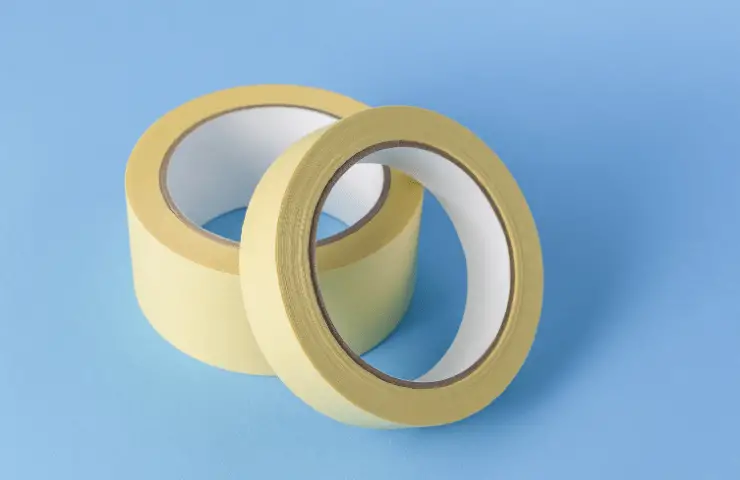
This is one of the inexpensive tricks to make the shoes slip-resistant. The best part of this technique is that it does not require a specific set of tools, as masking tape can usually be found in your home.
One side of the masking tape is adhesive that sticks to the bottom of the shoes. The other side is either rough or sticky enough to add grip to the bottom of the shoes.
Here are the steps you can follow to apply masking tape for making shoes non slip for work.
- Like other methods, clean the shoe bottom with rubbing alcohol to wipe out dirt and dust.
- To achieve the maximum slip resistance, apply the masking tape diagonally to form an X pattern.
- Focus more on the ball of foot and heel regions of the bottom of the shoes with maximum contact with the surface.
- Press down the masking tape firmly so that it does not get detached when instantly when you start walking.
Note: The downside of this technique is that masking tape loses its adhesiveness and detaches from the bottom of the shoes over time due to dirt and debris causing wear and tear.
9. Apply a mixture of Salt and Rubber Glue for Making Shoes Slip-Resistant
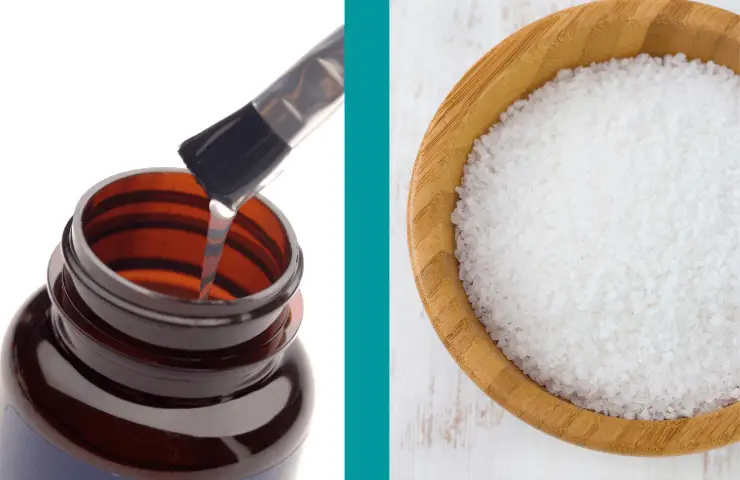
With each method we have explained, we are trying to increase the shoe traction by adding grip to the bottom.
You must be thinking that the writer is freaking crazy, suggesting applying glue and salt solution to your expensive shoes. Believe me, this technique seems a bit unconventional, but it has worked for my shoes. Adding the salt to glue gives a granular texture to the solution that helps to improve the traction by creating a rough coating on the bottom of the shoes.
The advantage of applying this technique is that it poses a long-lasting effect on the bottom of the shoes to make them slip-resistant.
The procedure to use this technique is almost the same.
- First, clean the bottom of the shoes with rubbing alcohol.
- In a bowl, mix some grains of salt with glue and make a thin solution.
- Use a brush to apply the glue salt paste on the most focused regions of the sole.
- Finally, leave the shoes to dry for some time.
Note: Keep in mind that due to the granularity of the salt, the more you add it to the mixture, the more will be the grip and slip resistance of the shoes. Also, make sure that you use rubber glue as regular glue can damage the quality of your shoe bottom material.
Final Thoughts
So, these are all our most effective and tested hacks on how to make shoes non-slip for work. If you are afraid of damaging the quality of the shoes as you are not an expert to deal with the shoes, it would be better to be near a cobbler as these guys are experts in their field and can make shoes slip-resistant with their perfection.
I hope you will find all the tips and tricks detailed in this article valuable enough to implement them. If you still have any questions, do put them in the comment section below. I will try to give a satisfactory answer to your queries based on my expertise.
Also, don’t forget to share this article with your friends and loved ones if you want to prevent them from severe injuries due to slipping.
Happy learning!
